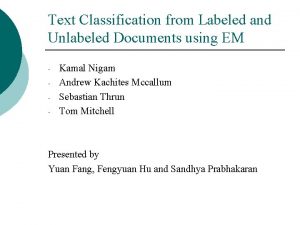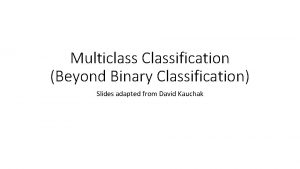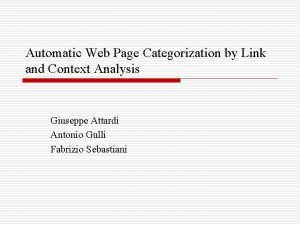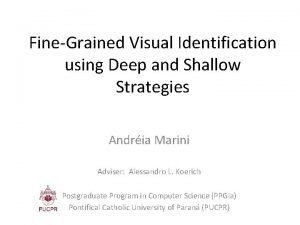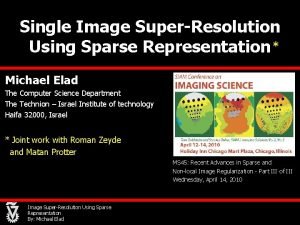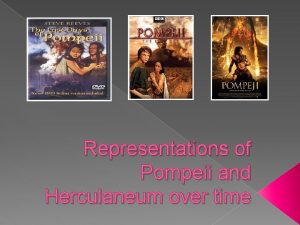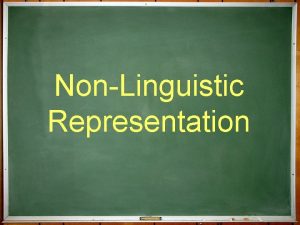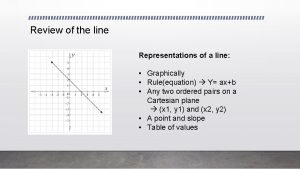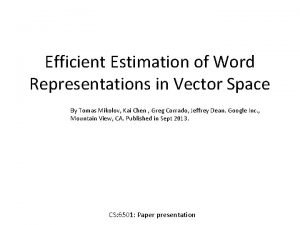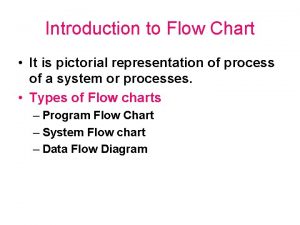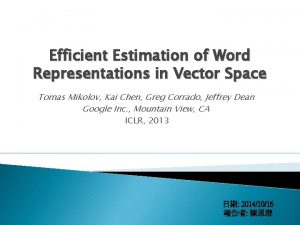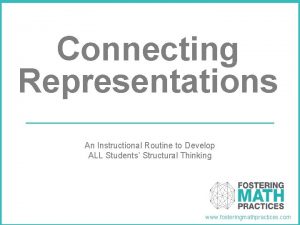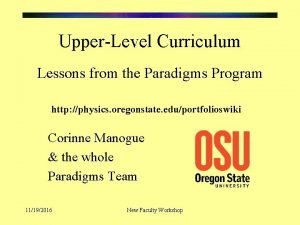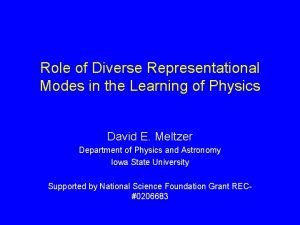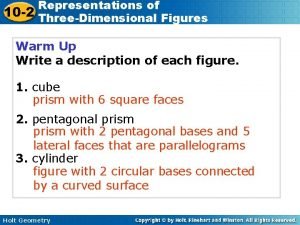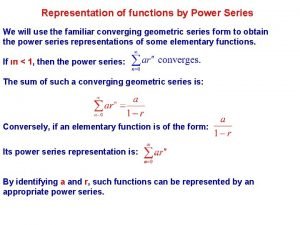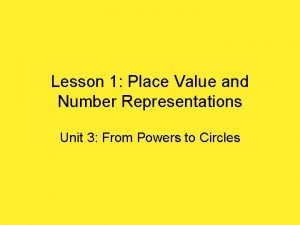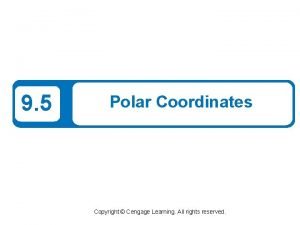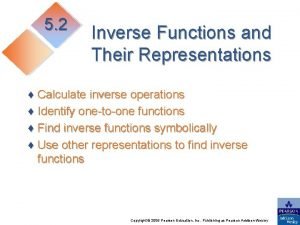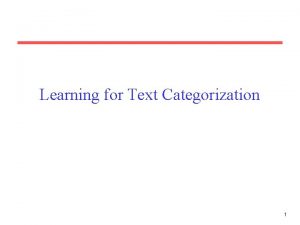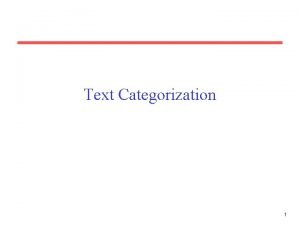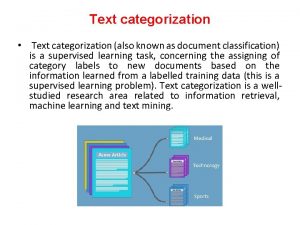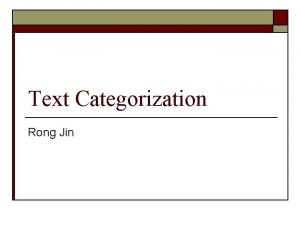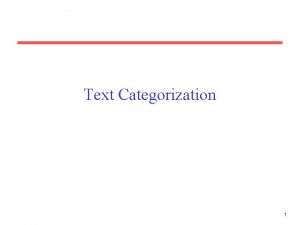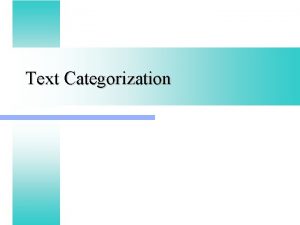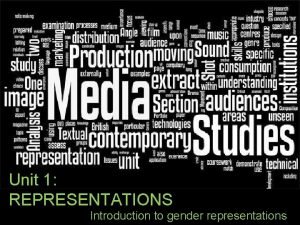Learning for Text Categorization 1 Text Categorization Representations



































- Slides: 35

Learning for Text Categorization 1

Text Categorization • Representations of text are very high dimensional (one feature for each word). • High-bias algorithms that prevent overfitting in high-dimensional space are best. • For most text categorization tasks, there are many irrelevant and many relevant features. • Methods that sum evidence from many or all features (e. g. naïve Bayes, KNN, neural-net) tend to work better than ones that try to isolate just a few relevant features (decision-tree or rule induction). 2

Naïve Bayes for Text • Modeled as generating a bag of words for a document in a given category by repeatedly sampling with replacement from a vocabulary V = {w 1, w 2, …wm} based on the probabilities P(wj | ci). • Smooth probability estimates with Laplace m-estimates assuming a uniform distribution over all words (p = 1/|V|) and m = |V| – Equivalent to a virtual sample of seeing each word in each category exactly once. 3

Text Naïve Bayes Algorithm (Train) Let V be the vocabulary of all words in the documents in D For each category ci C Let Di be the subset of documents in D in category ci P(ci) = |Di| / |D| Let Ti be the concatenation of all the documents in Di Let ni be the total number of word occurrences in Ti For each word wj V Let nij be the number of occurrences of wj in Ti Let P(wi | ci) = (nij + 1) / (ni + |V|) 4

Text Naïve Bayes Algorithm (Test) Given a test document X Let n be the number of word occurrences in X Return the category: where ai is the word occurring the ith position in X 5

Naïve Bayes Time Complexity • Training Time: O(|D|Ld + |C||V|)) where Ld is the average length of a document in D. – Assumes V and all Di , ni, and nij pre-computed in O(|D|Ld) time during one pass through all of the data. – Generally just O(|D|Ld) since usually |C||V| < |D|Ld • Test Time: O(|C| Lt) where Lt is the average length of a test document. • Very efficient overall, linearly proportional to the time needed to just read in all the data. • Similar to Rocchio time complexity. 6

Underflow Prevention • Multiplying lots of probabilities, which are between 0 and 1 by definition, can result in floating-point underflow. • Since log(xy) = log(x) + log(y), it is better to perform all computations by summing logs of probabilities rather than multiplying probabilities. • Class with highest final un-normalized log probability score is still the most probable. 7

Naïve Bayes Posterior Probabilities • Classification results of naïve Bayes (the class with maximum posterior probability) are usually fairly accurate. • However, due to the inadequacy of the conditional independence assumption, the actual posterior-probability numerical estimates are not. – Output probabilities are generally very close to 0 or 1. 8

Textual Similarity Metrics • Measuring similarity of two texts is a well-studied problem. • Standard metrics are based on a “bag of words” model of a document that ignores word order and syntactic structure. • May involve removing common “stop words” and stemming to reduce words to their root form. • Vector-space model from Information Retrieval (IR) is the standard approach. • Other metrics (e. g. edit-distance) are also used. 9

The Vector-Space Model • Assume t distinct terms remain after preprocessing; call them index terms or the vocabulary. • These “orthogonal” terms form a vector space. Dimension = t = |vocabulary| • Each term, i, in a document or query, j, is given a real-valued weight, wij. • Both documents and queries are expressed as tdimensional vectors: dj = (w 1 j, w 2 j, …, wtj) 10

Graphic Representation Example: D 1 = 2 T 1 + 3 T 2 + 5 T 3 D 2 = 3 T 1 + 7 T 2 + T 3 Q = 0 T 1 + 0 T 2 + 2 T 3 5 D 1 = 2 T 1+ 3 T 2 + 5 T 3 Q = 0 T 1 + 0 T 2 + 2 T 3 2 3 T 1 D 2 = 3 T 1 + 7 T 2 + T 3 T 2 7 • Is D 1 or D 2 more similar to Q? • How to measure the degree of similarity? Distance? Angle? Projection? 11

Document Collection • A collection of n documents can be represented in the vector space model by a term-document matrix. • An entry in the matrix corresponds to the “weight” of a term in the document; zero means the term has no significance in the document or it simply doesn’t exist in the document. T 1 T 2 …. Tt D 1 w 11 w 21 … wt 1 D 2 w 12 w 22 … wt 2 : : : : Dn w 1 n w 2 n … wtn 12

Term Weights: Term Frequency • More frequent terms in a document are more important, i. e. more indicative of the topic. fij = frequency of term i in document j • May want to normalize term frequency (tf) by dividing by the frequency of the most common term in the document: tfij = fij / maxi{fij} 13

Term Weights: Inverse Document Frequency • Terms that appear in many different documents are less indicative of overall topic. df i = document frequency of term i = number of documents containing term i idfi = inverse document frequency of term i, = log 2 (N/ df i) (N: total number of documents) • An indication of a term’s discrimination power. • Log used to dampen the effect relative to tf. 14

TF-IDF Weighting • A typical combined term importance indicator is tf -idf weighting: wij = tfij idfi = tfij log 2 (N/ dfi) • A term occurring frequently in the document but rarely in the rest of the collection is given high weight. • Many other ways of determining term weights have been proposed. • Experimentally, tf-idf has been found to work well. 15

Computing TF-IDF -- An Example Given a document containing terms with given frequencies: A(3), B(2), C(1) Assume collection contains 10, 000 documents and document frequencies of these terms are: A(50), B(1300), C(250) Then: A: tf = 3/3; idf = log(10000/50) = 5. 3; tf-idf = 5. 3 B: tf = 2/3; idf = log(10000/1300) = 2. 0; tf-idf = 1. 3 C: tf = 1/3; idf = log(10000/250) = 3. 7; tf-idf = 1. 2 16

Similarity Measure • A similarity measure is a function that computes the degree of similarity between two vectors. • Using a similarity measure between the query and each document: – It is possible to rank the retrieved documents in the order of presumed relevance. – It is possible to enforce a certain threshold so that the size of the retrieved set can be controlled. 17

Similarity Measure - Inner Product • Similarity between vectors for the document di and query q can be computed as the vector inner product: sim(dj, q) = dj • q = wij · wiq where wij is the weight of term i in document j and wiq is the weight of term i in the query • For binary vectors, the inner product is the number of matched query terms in the document (size of intersection). • For weighted term vectors, it is the sum of the products of the weights of the matched terms. 18

Properties of Inner Product • The inner product is unbounded. • Favors long documents with a large number of unique terms. • Measures how many terms matched but not how many terms are not matched. 19

Inner Product -- Examples Binary: nt ion re r e u m at al ase tect ute e v g e ab hi p t a form i r n t c t m x re da ar co te ma in – D = 1, 1, 1, 0, 1, 1, – Q = 1, 0 , 1, 0, 0, 1, 0 Size of vector = size of vocabulary = 7 0 means corresponding term not found in 1 document or query sim(D, Q) = 3 Weighted: D 1 = 2 T 1 + 3 T 2 + 5 T 3 Q = 0 T 1 + 0 T 2 + 2 T 3 D 2 = 3 T 1 + 7 T 2 + 1 T 3 sim(D 1 , Q) = 2*0 + 3*0 + 5*2 = 10 sim(D 2 , Q) = 3*0 + 7*0 + 1*2 = 2 20

Cosine Similarity Measure t 3 • Cosine similarity measures the cosine of the angle between two vectors. • Inner product normalized by the vector lengths. 1 D 1 2 Cos. Sim(dj, q) = t 2 Q t 1 D 2 D 1 = 2 T 1 + 3 T 2 + 5 T 3 Cos. Sim(D 1 , Q) = 10 / (4+9+25)(0+0+4) = 0. 81 D 2 = 3 T 1 + 7 T 2 + 1 T 3 Cos. Sim(D 2 , Q) = 2 / (9+49+1)(0+0+4) = 0. 13 Q = 0 T 1 + 0 T 2 + 2 T 3 D 1 is 6 times better than D 2 using cosine similarity but only 5 times better using inner product. 21

K Nearest Neighbor for Text Training: For each training example <x, c(x)> D Compute the corresponding TF-IDF vector, dx, for document x Test instance y: Compute TF-IDF vector d for document y For each <x, c(x)> D Let sx = cos. Sim(d, dx) Sort examples, x, in D by decreasing value of sx Let N be the first k examples in D. (get most similar neighbors) Return the majority class of examples in N 22

Illustration of 3 Nearest Neighbor for Text 23

3 Nearest Neighbor Comparison • Nearest Neighbor tends to handle polymorphic categories better. 24

Nearest Neighbor Time Complexity • Training Time: O(|D| Ld) to compose TF-IDF vectors. • Testing Time: O(Lt + |D||Vt|) to compare to all training vectors. – Assumes lengths of dx vectors are computed and stored during training, allowing cos. Sim(d, dx) to be computed in time proportional to the number of non-zero entries in d (i. e. |Vt|) • Testing time can be high for large training sets. 25

Nearest Neighbor with Inverted Index • Determining k nearest neighbors is the same as determining the k best retrievals using the test document as a query to a database of training documents. • Use standard VSR inverted index methods to find the k nearest neighbors. • Testing Time: O(B|Vt|) where B is the average number of training documents in which a test-document word appears. • Therefore, overall classification is O(Lt + B|Vt|) – Typically B << |D| 26

Relevance Feedback in IR • After initial retrieval results are presented, allow the user to provide feedback on the relevance of one or more of the retrieved documents. • Use this feedback information to reformulate the query. • Produce new results based on reformulated query. • Allows more interactive, multi-pass process. 27

Relevance Feedback Architecture Document corpus Query String Revise d Query Reformulation Feedback 1. Doc 1 2. Doc 2 3. Doc 3 . . Rankings Re. Ranked Documents IR System Ranked Documents 1. Doc 1 2. Doc 2 3. Doc 3. . 1. Doc 2 2. Doc 4 3. Doc 5. . 28

Using Relevance Feedback (Rocchio) • Relevance feedback methods can be adapted for text categorization. • Use standard TF/IDF weighted vectors to represent text documents (normalized by maximum term frequency). • For each category, compute a prototype vector by summing the vectors of the training documents in the category. • Assign test documents to the category with the closest prototype vector based on cosine similarity. 29

Rocchio Text Categorization Algorithm (Training) Assume the set of categories is {c 1, c 2, …cn} For i from 1 to n let pi = <0, 0, …, 0> (init. prototype vectors) For each training example <x, c(x)> D Let d be the frequency normalized TF/IDF term vector for doc x Let i = j: (cj = c(x)) (sum all the document vectors in ci to get pi) Let pi = pi + d 30

Rocchio Text Categorization Algorithm (Test) Given test document x Let d be the TF/IDF weighted term vector for x Let m = – 2 (init. maximum cos. Sim) For i from 1 to n: (compute similarity to prototype vector) Let s = cos. Sim(d, pi) if s > m let m = s let r = ci (update most similar class prototype) Return class r 31

Illustration of Rocchio Text Categorization 32

Rocchio Properties • Does not guarantee a consistent hypothesis. • Forms a simple generalization of the examples in each class (a prototype). • Prototype vector does not need to be averaged or otherwise normalized for length since cosine similarity is insensitive to vector length. • Classification is based on similarity to class prototypes. 33

Rocchio Anomoly • Prototype models have problems with polymorphic (disjunctive) categories. 34

Rocchio Time Complexity • Note: The time to add two sparse vectors is proportional to minimum number of non-zero entries in the two vectors. • Training Time: O(|D|(Ld + |Vd|)) = O(|D| Ld) where Ld is the average length of a document in D and Vd is the average vocabulary size for a document in D. • Test Time: O(Lt + |C||Vt|) where Lt is the average length of a test document and |Vt | is the average vocabulary size for a test document. – Assumes lengths of pi vectors are computed and stored during training, allowing cos. Sim(d, pi) to be computed in time proportional to the number of non-zero entries in d (i. e. |Vt|) 35
 What is text categorization
What is text categorization Jag har nigit för nymånens skära text
Jag har nigit för nymånens skära text What is an example of a text-to-media connection?
What is an example of a text-to-media connection? Pineapple categorization binary
Pineapple categorization binary Web page categorization
Web page categorization Prototype psych
Prototype psych Fine-grained visual categorization
Fine-grained visual categorization The definitional approach to categorization
The definitional approach to categorization Cuadro comparativo de e-learning b-learning y m-learning
Cuadro comparativo de e-learning b-learning y m-learning On single image scale-up using sparse-representations
On single image scale-up using sparse-representations Representations of pompeii and herculaneum over time
Representations of pompeii and herculaneum over time What is non linguistic representation
What is non linguistic representation Episode graphic organizer
Episode graphic organizer Gcse media studies nea 2021
Gcse media studies nea 2021 Representations of a line
Representations of a line Cultural representations and signifying practices
Cultural representations and signifying practices Efficient estimation of word representation in vector space
Efficient estimation of word representation in vector space Distributed representations of words
Distributed representations of words Isa 580
Isa 580 Maps and plans
Maps and plans Types of maps in maths lit
Types of maps in maths lit Maps plans and other representations of the physical world
Maps plans and other representations of the physical world Flowchart pictorial representation
Flowchart pictorial representation Efficient estimation of word representations
Efficient estimation of word representations Connecting representations
Connecting representations Multiple representations
Multiple representations Multiple representations
Multiple representations Representations of three dimensional figures
Representations of three dimensional figures Representations of functions as power series
Representations of functions as power series Character table for d infinity h
Character table for d infinity h Maps, plans and other representations of the physical world
Maps, plans and other representations of the physical world Place value representations
Place value representations Economics
Economics Multiple representations of polar coordinates
Multiple representations of polar coordinates Functions and their representations
Functions and their representations Fspos vägledning för kontinuitetshantering
Fspos vägledning för kontinuitetshantering
